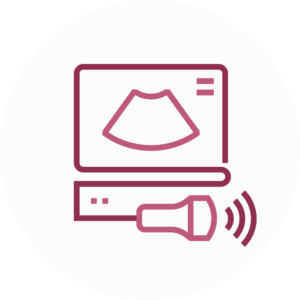Dias laborables
M/F: 8:30AM - 6PM | 한국말로 도와드립니다
평일
7:30AM - 3:30PM
Dias laborables
M/F: 8:30AM - 6PM
평일
7:30AM - 3:30PM
General Ultrasound
General Ultrasound Procedures
 Review commonly asked questions in our ultrasound FAQ
Review commonly asked questions in our ultrasound FAQ
An ultrasounds is quick, generally painless, and safe for nearly everyone because no radiation is emitted. In addition to diagnosing the source of pain, swelling, and/or infection; ultrasound is frequently used throughout pregnancy to monitor fetal development.
During an ultrasound, also referred to as a sonogram, one of our technologists applies ultrasound gel to the area(s) being studied. Then she gently slides a transducer over the area(s). The ultrasound transducer generates high-frequency sound waves to produce digital images of the area(s) being studied.
Bergen Imaging Center offers a number of specialized ultrasounds, including: Abdominal Ultrasounds, Pelvic/Transabdominal and Transvaginal Ultrasounds, First Trimester Obstetrical Ultrasounds, Renal and Bladder Ultrasounds and Thyroid Ultrasounds.
Abdominal Ultrasound
Abdominal sonograms examine abdominal organs, including the liver, gallbladder, spleen, pancreas, and kidneys.
Pelvic Sonogram/ Transabdominal or Transvaginal
Pelvic sonograms examine the uterus, cervix, fallopian tubes, bladder, and ovaries.
First Trimester Obstetrical (OB) Ultrasounds
First trimester OB ultrasounds monitor fetal development to ensure a healthy and complication-free pregnancy.
Renal and Bladder Ultrasound
Renal and bladder ultrasounds examine the kidney, ureters, and bladder.
Thyroid Ultrasound
Thyroid ultrasounds examine the thyroid, parathyroid, and other structures in the neck.
Scrotal Ultrasound
Scrotal ultrasounds examine the scrotum and testicles.
Ultrasound FAQ
Ultrasound imaging, also known as ultrasound scanning or sonography, involves exposing part of the body to high-frequency sound waves to produce pictures of the inside of the body. Ultrasound exams don’t use ionizing radiation (as used in x-rays). Because ultrasound images are captured in real-time, they can show the structure and movement of the body’s internal organs, as well as blood flowing through blood vessels.
Ultrasound imaging is a non-invasive medical test that helps physicians diagnose and treat medical conditions.
You should wear comfortable, loose-fitting clothes for your ultrasound exam. You may have to remove all clothing and jewelry in the area to be examined.
Tell your doctor if you have had a barium enema or a series of upper GI (gastrointestinal) tests within the past two days. Barium that remains in the intestines can interfere with the ultrasound test.
Other preparations depend on the kind of ultrasound you are having.
- For a study of the liver, gallbladder, spleen, and pancreas, you might be asked to eat a fat-free meal on the evening before the test and then to avoid eating for eight to 12 hours before the test.
- For ultrasound of the kidneys, you might be asked to drink four to six glasses of liquid about an hour before the test to fill your bladder. You may be asked to avoid eating for eight to 12 hours before the test to avoid gas buildup in the intestines.
Ultrasound imaging is performed to evaluate the:
- Breasts
- Kidneys
- Liver
- Gallbladder
- Pancreas
- Spleen
- Uterus and ovaries
- Abdominal aorta and other blood vessels of the abdomen
- Thyroid
